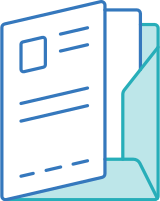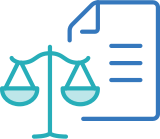
Banking tips to get better financing for your business
Key tips on how to optimize business financing from your bank.

In this guide, we’ll cover:
If your company is in growth mode, you may be facing a good news/bad news scenario: Sales are up, but managing your cash flow is increasingly complicated and you need additional financing to keep up with demand. This guide provides key tips on how to optimize business financing from your bank.
Case in point: A new international customer approaches you with a great opportunity that could take you to the next level—and beyond.
One catch: They want longer payment terms.
Your dilemma: You can’t say, “No,” but saying, “Yes” would push you into a precarious cash crunch.
You’re not alone. Our research shows that financing is one of the biggest challenges for Canadian exporting companies, especially when expanding into new markets, or increasing their cash flow to deliver on a new contract.
Follow these tips to solidify your relationship with your financial institution
Before you reach out to your financial institution (FI) for financing, find out more about how bankers think, how FIs operate and what you need to set yourself up for success. It’s going to take more than just a solid business plan. You’ll need to develop a strategy that identifies your must-haves to build your business case. Follow these winning tips to maximize the conversation—and your outcome.
Understanding your financial institution
It’s important to know how FIs, including national and regional banks, credit unions and other lenders, operate in general to maximize your borrowing capacity. Some basic operating principles to keep in mind:
- The difference between being bankable and being lendable
- All companies with financial data are bankable: You can open a business account, deposit revenues and pay your company’s bills.
- To be considered lendable, you typically need at least three years’ worth of financial statements, plus assets, inventory, or accounts receivable as collateral. You’ll also need to have a minimum risk rating. It’s critical that you know how your company performs on paper before asking your banker for additional financing.
- How financial institutions evaluate creditworthiness
The process FIs use to evaluate creditworthiness is changing. It takes several people to evaluate every company that walks through the door, so bankers have moved to a more behavioural-based model to calculate credit scores. The score you’re given generally combines performance data from companies similar to yours and an analysis of your business’s history with your current FI (including borrowing and repayments, cash cycle, customer payment terms, and more).
- Banks often aren’t able to recognize foreign assets
Most banks are reluctant to assign value to assets located outside Canada, including any foreign accounts receivable you have. Why? Because if you’re unable to pay back the money you owe, it’s much harder for them to recoup their losses by claiming or liquidating collateral assets located outside Canada. That reality ends up reducing the amount of financing you can get, plus limits the size and number of contracts you can take on at one time.
- Competition for loan dollars
When you ask your bank for financing, you’re actually competing against other businesses for loan dollars. So, it’s critical that you present your case effectively and efficiently. We detail the must-haves in the next section.
- Time constraints of account managers
Chances are, your FI account manager is juggling a large portfolio of clients, each with their own unique backgrounds, plans and needs. Providing a clear business plan and financial statements will help you achieve a positive outcome from your meeting.
Must-haves to bring to your financial institution
Now that you know how your financial institution—and banker—operate, it’s time to get your documents in order and your pitch perfected.
1. Determine your ask

This may seem obvious, but spend a little time clarifying your ask, or defining the problem that you want your FI to support. Is your objective to finance a gap between the payment of your suppliers and your customer’s payment terms? Do you need to purchase more raw materials for a new, unusually large contract? Being able to share your pain points will help your FI account manager decide which solution—loan, line of credit or another solution—best meets your needs.
- Loans have a non-revolving credit limit, which means you have access to the funds only once, and then you make principal and interest payments until the debt is paid off.
- With a line of credit, you receive a set credit limit similar to a credit card. You then make regular payments that include both principal and interest. Unlike a loan, you’ll have continuous and repeated access to the line of credit while it’s active.
2. Gather your financials

Financial institutions typically prefer to lend to mature companies. Ideally, you’ll need to have three years of financial statements ready to provide your business history—if you don’t have three years of statements, or your future plans don’t follow the established trend of your past performance, be ready to share projections to explain your plans. Financial institutions may consider financing a specific transaction (rather than an open-ended loan) to help establish your credibility with them. For example, if your company is less than three years old, but has solid foundations and you need extra cash to fulfill a large order.
3. Assess your collateral

Keep in mind, for a small business line of credit, financial institutions typically ask for $2 in collateral for every $1 they offer. You’ll need to be clear about how much collateral you can provide to back your loan or credit line. Collateral includes capital assets, inventory, or accounts receivable.
- Capital assets: These include real estate and equipment. Financial institutions don’t generally like to accept capital assets as collateral because they’re harder to liquidate. But it can’t hurt to include them.
- Inventory: Financial institutions usually accept inventory as an asset at a rate of 50 cents on the dollar. Valuation will also depend on the quality of your inventory and your company’s inventory turnover. Canada is one of only a few countries that applies this borrowing practice.
- Accounts receivable: For domestic receivables with payment terms under 90 days, a bank may only give you 65 cents on the dollar, and zero for receivables outside of Canada. But if you have credit insurance, you’ll typically get 90 cents on the dollar for both domestic and international receivables (more details below).
4. Perfect your pitch

As mentioned earlier, your banker can’t provide working capital to every business that asks, so make sure you stand out from the crowd. Go in with a presentation—one that strikes the right balance between entrepreneurial passion and solid financials. Bankers like to feel the excitement you have for your company, but they also want to know you have a solid plan.
- Be ready to talk about why you need more working capital and tell a story about what makes your business unique.
- If there’s a certain market you want to enter, you need to be prepared to speak about the risks and opportunities in that market.
- Be ready to explain why you want to expand your business there, and what long-term success looks like for your company.
5. Reduce your bank’s risk

Your bank is more likely to provide you with working capital when they know their risks are covered. They need to know they can recoup losses if you’re unable to pay back the money borrowed. One of the most effective ways to reduce your bank’s risk is by working with Export Development Canada (EDC). We’ve developed financial solutions specifically designed to help you do business in international markets by reducing your financial institution’s risk. Read on to understand how.
How EDC can work for you and your financial institution
We’re focused on helping companies, like yours, increase your share of international business opportunities, and get access to the financing you need to grow and succeed in markets, including the United States, the rapidly growing Indo-Pacific and other global markets.
If you’ve maxed out the working capital your financial institution is willing to extend to you through a loan, or line of credit, EDC’s solutions can share your FI’s risk associated with lending towards your exporting activities. This builds the FI’s capacity to lend to you, so you can access additional financing.
Not sure if you’re an exporter?
If you answer “Yes” to any of these questions, EDC considers you an exporter.
- Are you currently selling goods or services outside of Canada?
- Do you create a good and/or service that forms part of a global supply chain?
- Do you have a plan to export goods or services in the future?
Learn more about how EDC defines “exporting” and who we can help.
How we can help your financial institution recognize your foreign assets
Earlier, we pointed out that most banks will give you zero collateral credit for receivables outside Canada? If your financial institution is unable to recognize your foreign assets—including your foreign receivables— EDC Credit Insurance can help. With our credit insurance in place, your bank has the assurance that if your customer doesn’t pay, we will. Which means they can lend against your insured invoices for up to 90% of their value, significantly increasing your access to cash.
How we can help you maximize working capital from your financial institution
You might be thrilled with your company’s growth, especially if you’re getting orders from previously untapped markets abroad. But sometimes, financial institutions are concerned if your growth is too rapid, especially if a large percentage is based outside Canada.
That’s where we come in.
EDC partners with nearly all Canadian financial institutions to understand and fill the gap when they’re challenged to support the growth of exporters, like you. We have an entire solution suite that increases your access to working capital by reducing your FI’s risk. With our working capital guarantees, we take on international risk, giving your FI the confidence to offer you more favourable lending options, or free up assets that they’d otherwise hold as collateral.
Could a working capital guarantee help your company grow?
If any of these situations apply to you, then an EDC working capital guarantee might be exactly what you need to make your company’s growth a reality.
- You’re taking on new international customers, or global contracts, but facing a cash crunch between winning the business and getting paid.
- You’re buying new equipment, or warehousing inventory closer to foreign buyers, but your operating line facility is maxed out.
- You’re using assets as collateral against a letter of guarantee, standby letter of credit, or foreign exchange contract.
- You’re opening an international office or acquiring an affiliate, but your financial institution isn’t able to support growth through international assets.
Now you know how EDC can help you; Does your financial institution know about EDC?
When you’re talking to your FI about increasing your working capital, be sure to ask if any of EDC’s solutions would work for your business. If they don’t know about EDC, ask your financial institution account manager to give us a call at 1-800-229-0575, so we can help them help you get the most from your relationship, and the financing you need to realize your business goals.